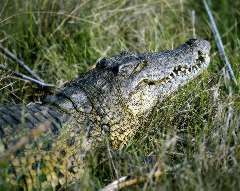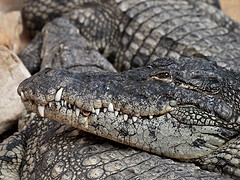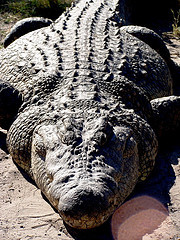Factsheet
Crocodile
Crocodilians are the closest surviving relatives of the great dinosaurs. They have changed very little during the 150 million years that they have lived on Earth.
Overview
 Order: Crocodilia
Order: Crocodilia
Family: Crocodylidae
Distribution: Madagascar, Egypt and central Africa, south to Namibia, Botswana and Zimbabwe.
Habitat: Mainly large rivers, lakes, waterholes and wetlands; also estuaries and mangrove swamps.
Size: Average 3.5m, but up to 5.5m.
Description: A long body armoured with bony plates set in the skin of the back; long deep-sided tail, short limbs and long-snouted skull.
Lifespan: Ages of over 56 years have been recorded. Estimated to live 70 - 100 years. Some have lived even longer. Having resided in the Australia Zoo as one of its oldest residents, Mr Freshie was a freshwater crocodile that lived to be 140 years old making him the oldest known crocodile to ever be put in captivity.
Diet: Mammals, birds, reptiles, fish and carrion.
There are between 5 000 - 6 000 species of reptiles in the world today, and of these 23 are crocodilians. One family of crocodilians includes the crocodiles, alligators and caimans - Crocodylidae; the second family, Gavialidae, has only one member - the gharial or gavial (a very narrow-snouted crocodile).
Crocodilians are the closest surviving relatives of the great dinosaurs and they have changed very little during the 150 million years that they have lived on Earth!
Alligator or crocodile? What is the difference?
 The answer is that there is very little difference between any of the crocodilians. The easiest to identify is the gharial because it has an extremely long, thin snout. True crocodiles have lower teeth which fit into notches either side of the outer upper jaw - protruding when the jaws are closed. Alligators and caimans have broader snouts than crocodiles and the lower teeth cannot be seen when the jaw is closed - all their upper jaw teeth hang over those in the lower jaw.
The answer is that there is very little difference between any of the crocodilians. The easiest to identify is the gharial because it has an extremely long, thin snout. True crocodiles have lower teeth which fit into notches either side of the outer upper jaw - protruding when the jaws are closed. Alligators and caimans have broader snouts than crocodiles and the lower teeth cannot be seen when the jaw is closed - all their upper jaw teeth hang over those in the lower jaw.
Geographically speaking, true crocodiles live in Africa, Asia and the Americas; alligators are found in China and the southern United States; caimans live in South America and the gharial in southern Asia.
Adaptations for a life in water
Crocodilians can move about on land - with surprising speed, particularly when alarmed or angry - but their bodies are mainly adapted for a life in water. The nostrils, eyes and ears lie along the top of the head so that the animal can hear, see, smell and breathe when the rest of the body is submerged.
When completely under the water, the ears are covered by small flaps of skin which can be closed to make the ears watertight. The nostrils can also be closed by special muscles, and the eyes have a 'third eyelid' which gives protection when diving.
There are special bony flaps in the throat which allow a crocodile to eat when submerged or breathe when its jaws are open underwater.
Crocodilians, being cold-blooded reptiles, have to avoid extremes of temperature. When it is fairly cool, they rest on a waterside bank, allowing the sun to warm their body. During the hottest part of the day, the animals will move into the shade or water to prevent their body from overheating.
The Nile Crocodile
The Nile Crocodile is one of the largest of all crocodilians (the estuarine crocodile, the most aquatic and marine of all crocodilians, living in South India, Indonesia and South Australia, is reputed to be the biggest of all). It preys on almost anything, including hoofed animals that drink at the water's edge, predatory fish - and sometimes humans! The crocodile uses its strong jaws and teeth to drag an animal underwater and drown it. It cannot chew, so it clamps its jaws and spins its own body to tear off large chunks of flesh. It eats every part of the body, including bones and antlers, which help digestion.
Breeding: Nile crocodiles begin to breed when they are around 2.5m in length - this may take 7 years to achieve. Mating occurs in the dry season and, when the rainy season begins, the female digs out a nest in a bank near the water. She lays up to 80 white hard-shelled eggs, covers them well with sand and guards them for about 3 months. When the young are ready to hatch, they begin to call with squeaky 'chirps' and their mother digs them out of the nest. As the miniature crocodiles (about 30cm long) hatch, the female gently picks up a few at a time in her jaws and carries them to a safe nursery area in the water. She will guard them from predators for several more weeks until they go off on their own. At first, the young feed on insects and then, as they grow (about 25cm a year), progress to crabs, birds and fish before tackling the adult diet.
Despite the mother's protection, very few crocodiles reach adulthood. Large lizards, mongooses, hyenas, birds, large fish and other crocodiles all eat hatchlings.
The Nile Crocodile and Humans
 Crocodiles were revered by the ancient Egyptians but nowadays they are generally regarded as ugly, fearsome and dangerous creatures. Relentless hunting has severely reduced a lot of crocodilians. As of 2020, 7 of the 23 crocodile species were listed as critically endangered and 4 were listed as vulnerable.
Crocodiles were revered by the ancient Egyptians but nowadays they are generally regarded as ugly, fearsome and dangerous creatures. Relentless hunting has severely reduced a lot of crocodilians. As of 2020, 7 of the 23 crocodile species were listed as critically endangered and 4 were listed as vulnerable.
The main reason for the over-hunting of crocodilians is the demand for their skins, which may be made into handbags, shoes, brief cases etc. During the 1950s some 5 - 10 million Nile crocodiles a year were killed for their skins.
Another threat to the crocodiles is destruction of their habitat - drainage of wetlands, clearance of riverside forests, trampling of nesting sites by cattle - have all reduced suitable habitat. Yet another problem is the use of new types of fishing nets called gill nets, in which crocodiles can become entangled and drown.
The Future?
Crocodilians play an important role in the ecology of their watery habitats. They act as scavengers, just as vultures, hyenas and jackals do on land, keeping the rivers and lakes clear of carrion (dead animals). They also eat large quantities of predatory fish, so helping to preserve suitable fish for humans.
Although legally protected in many places, crocodiles continue to be hunted. The best hope for their survival lies in the setting-up of sanctuaries within their existing habitats, where they are protected from hunters. Also, several projects have been started for breeding Nile crocodiles in captivity with the intention of restocking suitable rivers and lakes. Commercial crocodile farming is also being tried in a few countries, a small percentage of the crocodiles raised being used for restocking wild habitats, and the remainder used for skin products. It is most important that the skin trade is carefully monitored so that only farm-bred animals are used for leather goods. The illegal hunting of crocodilians must be stamped out if these interesting and useful reptiles are to survive in the wild.
Credits
Image: Crocodile by Tambako The Jaguar
Information sourced from:
Crocodilian Biology Database (2012), Frequently Asked Questions, How long do crocodiles live for? [online], Available from: http://crocodilian.com/cnhc/cbd-faq-q3.htm [accessed 01/06/2015].
Crocodiles of the World (2014), Conservation Status [online], Available from http://www.crocodilesoftheworld.co.uk/ conservation/conservation-status.html [accessed 17/06/2015].
 Order: Crocodilia
Order: Crocodilia
 The answer is that there is very little difference between any of the crocodilians. The easiest to identify is the gharial because it has an extremely long, thin snout. True crocodiles have lower teeth which fit into notches either side of the outer upper jaw - protruding when the jaws are closed. Alligators and caimans have broader snouts than crocodiles and the lower teeth cannot be seen when the jaw is closed - all their upper jaw teeth hang over those in the lower jaw.
The answer is that there is very little difference between any of the crocodilians. The easiest to identify is the gharial because it has an extremely long, thin snout. True crocodiles have lower teeth which fit into notches either side of the outer upper jaw - protruding when the jaws are closed. Alligators and caimans have broader snouts than crocodiles and the lower teeth cannot be seen when the jaw is closed - all their upper jaw teeth hang over those in the lower jaw. Crocodiles were revered by the ancient Egyptians but nowadays they are generally regarded as ugly, fearsome and dangerous creatures. Relentless hunting has severely reduced a lot of crocodilians. As of 2020, 7 of the 23 crocodile species were listed as critically endangered and 4 were listed as vulnerable.
Crocodiles were revered by the ancient Egyptians but nowadays they are generally regarded as ugly, fearsome and dangerous creatures. Relentless hunting has severely reduced a lot of crocodilians. As of 2020, 7 of the 23 crocodile species were listed as critically endangered and 4 were listed as vulnerable.